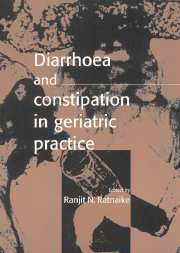Book contents
- Frontmatter
- Contents
- List of contributors
- Preface
- Acknowledgments
- Foreword by Gary R. Andrews
- I Defences of the aging gastrointestinal tract
- 1 Nonimmune defences of the aging gut
- 2 Immune defences of the aging gut
- II Diarrhoea
- III Noninfectious clinical entities
- IV Constipation
- V Perspectives of altered bowel function
- Index
1 - Nonimmune defences of the aging gut
Published online by Cambridge University Press: 17 August 2009
- Frontmatter
- Contents
- List of contributors
- Preface
- Acknowledgments
- Foreword by Gary R. Andrews
- I Defences of the aging gastrointestinal tract
- 1 Nonimmune defences of the aging gut
- 2 Immune defences of the aging gut
- II Diarrhoea
- III Noninfectious clinical entities
- IV Constipation
- V Perspectives of altered bowel function
- Index
Summary
In the elderly the nonimmunological defences of the gastrointestinal tract are an essential defence mechanism to protect the host against enteric infections. These defences, with aging, are compromised by a variety of external influences.
The nonimmunological defences are the first line of protection against enteric pathogens. The stomach, small intestine and colon are involved. Toxins are expelled by vomiting; pathogens are destroyed by gastric acid. The contact of toxins and bacteria with the small intestinal mucosa is minimized by the motility of the intestine. Pathogens which reach the colon are faced with a hostile population of commensal organisms, unwilling to relinquish their mutually beneficial relationship with their host.
Gastric defences
Vomiting
Vomiting ejects gastric contents and is the most primitive defence mechanism of the gastrointestinal tract. This powerful mechanism for ‘clearing’ and ‘cleansing’ gastric contents occurs through vigorous retrograde propulsion and is the most prominent feature of food poisoning due to ingested toxins.
The vomiting centre in the medulla is stimulated via afferent nerve impulses from chemoreceptors in the first part of the duodenum, which are sensitive to emetic substances. The ablation of this area eliminates vomiting despite the ingestion of these substances. Recent work points to an area separate from the vomiting centre in the medulla, called the area postrema or chemoreceptor trigger zone (CTZ), that is sensitive to substances circulating in the blood that cause vomiting.
Information
- Type
- Chapter
- Information
- Diarrhoea and Constipation in Geriatric Practice , pp. 3 - 9Publisher: Cambridge University PressPrint publication year: 1999
